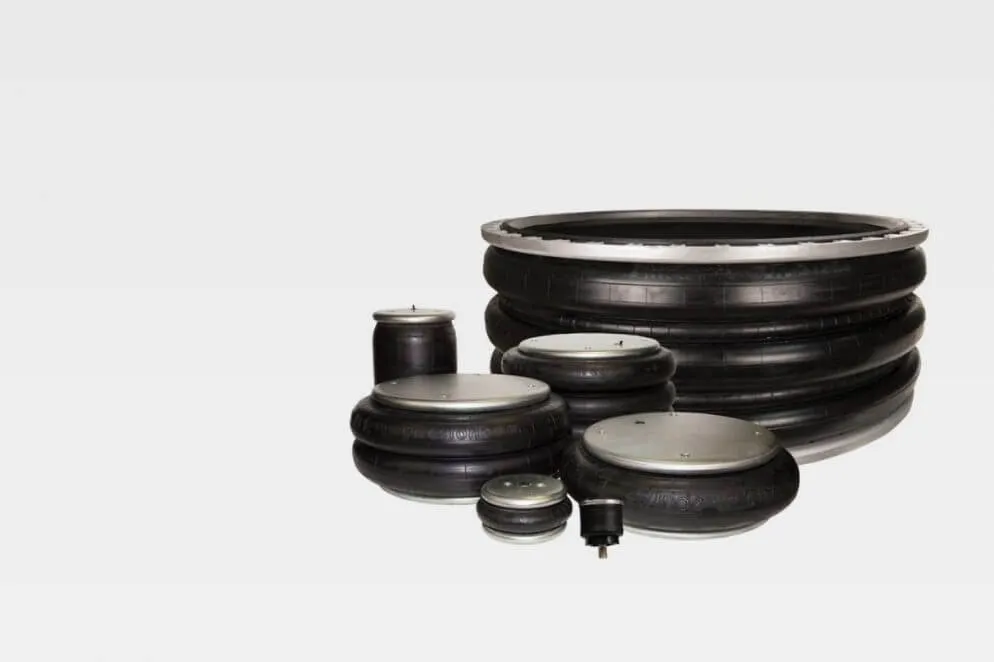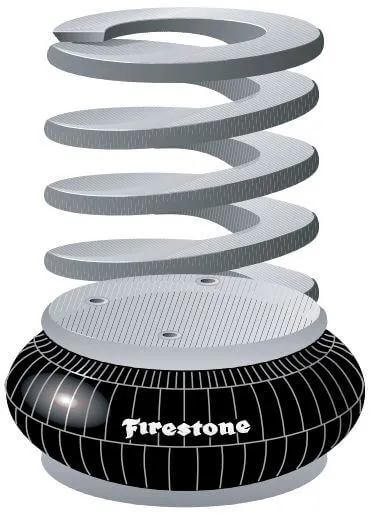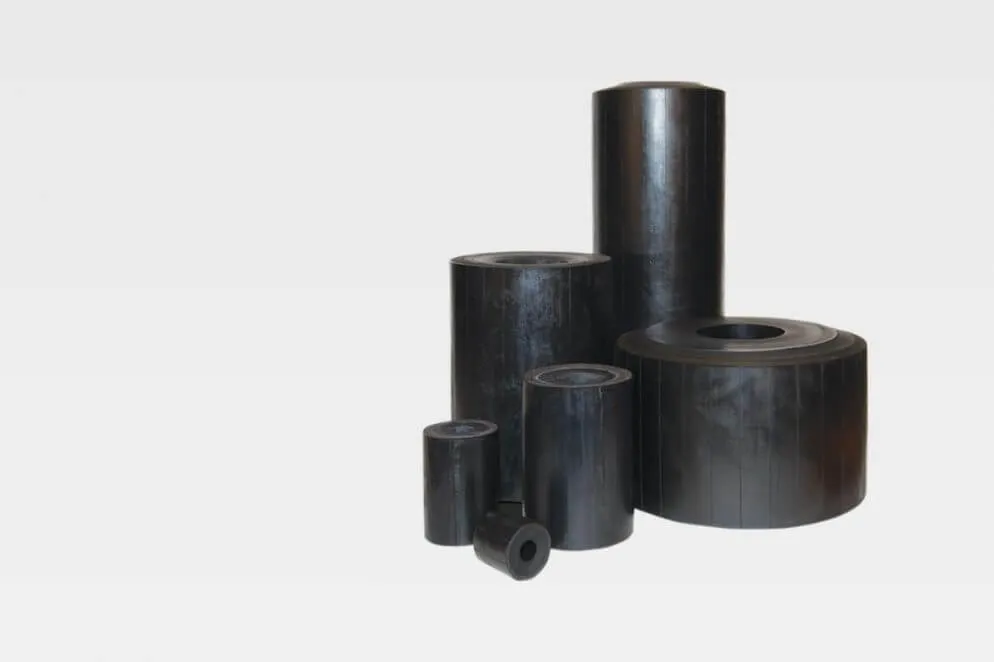ADVANTAGES OF FIRESTONE AIRSTROKE™ ACTUATORS
 Why use an Airstroke actuator (rather than air or hydraulic cylinder) for actuation?
Why use an Airstroke actuator (rather than air or hydraulic cylinder) for actuation?
LOW COST
Generally, initial cost is one-half or less than conventional pneumatic or hydraulic cylinders of the same force capabilities. This initial cost advantage is many times greater in the larger sizes.
DURABLE FOR LONG LIFE
Airstroke actuators are a further application of Firestone’s time proven Airide springs for truck and bus suspensions. The long life and durability necessary for millions of miles of heavy duty suspension use under adverse environmental conditions are also important factors in machine design.
FRICTION FREE FOR IMMEDIATE RESPONSE
Since Airstroke actuators have no sliding seals, there is no breakaway friction as with conventional cylinders
ANGULAR CAPABILITY
An Airstroke possesses the unique capability of stroking through an arc without a clevis. Angular motion of up to 30 degrees is possible, along with the design advantage of generally less complex linkages.
COMPACT STARTING HEIGHT
Airstroke actuators have a low profile compared to conventional cylinders. Our smallest Airstroke actuator (2.2 inch/dia.) collapses to just 1.1 inches in height, while our largest triple convoluted Airstroke (37 inch/dia.) will collapse to a very compact 5.5 inches.
WIDE SIZE RANGE
Airstroke actuators are available in sizes ranging from 2.2 inches to 37 inches in diameter. The force capability is up to 100,000 pounds. Strokes of up to 14 inches are possible.
NO MAINTENANCE OR LUBRICATION REQUIRED
NO INTERNAL ROD OR PISTON
Airstroke actuators have no internal rod, piston, or sliding seals as do conventional cylinders. This allows for the design of Airstroke actuators into applications where dirt or grit would destroy the seals on conventional cylinders.
FLEXIBLE MEDIA
An Airstroke actuator can do its work with either a liquid or gas
SIDE LOADING CAPABILITY
Airstroke actuators, within certain limits, are not affected by side loads as are conventional cylinders. This misalignment capability eliminates potential rod bending, scoring, and excessive seal wear common to conventional cylinders.
FACTORY SEALED AND TESTED
Most Airstroke actuators feature Firestone’s proven concept of crimped end plates. The crimped design allows for preshipment testing and quicker installation on equipment.
Imperial catalog Metric catalogADVANTAGES OF FIRESTONE
AIRMOUNT™ ISOLATORS
Why use an Airmount isolator rather than a coil spring or other type of isolator?
 Why use an Airmount isolator rather than a coil spring or other type of isolator?
Why use an Airmount isolator rather than a coil spring or other type of isolator?
UNSURPASSED ISOLATION CAPABILITY
Airmount isolators can provide the highest degree of isolation of any type vibration isolator. System natural frequencies as low as 60 cycles per minute (1 Hertz) are available. The addition of an auxiliary reservoir can provide even lower system frequencies. In order to achieve similar results from a conventional coil spring isolator, a real deflection of 9 inches would be required.
UNSURPASSED ISOLATION CAPABILITY
Airmount isolators can provide the highest degree of isolation of any type vibration isolator. System natural frequencies as low as 60 cycles per minute (1 Hertz) are available. The addition of an auxiliary reservoir can provide even lower system frequencies. In order to achieve similar results from a conventional coil spring isolator, a real deflection of 9 inches would be required.
ACCURATE HEIGHT CONTROL
Airmount isolators provide accurate height control through regulation of internal air pressure. This feature eliminates the fatigue and permanent set found in the use of other types of vibration isolators.
COMPACT INSTALLED HEIGHT
Airmount isolators can carry the loads and provide the isolation described above at installed heights as low as 2.5 inches. Coil springs providing equal isolation would require a free height of 5 to 25 inches.
EFFECTIVE NOISE REDUCTION
Airmount isolators reduce structurally transmitted noise. Airmount isolators are also quiet in themselves, since there is no spring chatter as found in conventional coil springs.
CONSTANT ISOLATION EFFICIENCY
Airmount isolators are unique in that the system’s natural frequency does not change significantly with changes in load. This unique feature, combined with accurate height control, will allow the use of the same Airmount isolator at each mounting point of an unevenly loaded machine.
CONSTANT ISOLATION EFFICIENCY
Airmount isolators are unique in that the system’s natural frequency does not change significantly with changes in load. This unique feature, combined with accurate height control, will allow the use of the same Airmount isolator at each mounting point of an unevenly loaded machine.
WIDE SIZE RANGE
Airmount isolators are capable of isolating loads of 100 pounds per mounting point to over 100,000 pounds per mounting point.
EXTENDED EQUIPMENT LIFE
Airmount isolators extend equipment life through their superior isolation capabilities.
VERSATILE
Airmount isolators can be used not only to protect structural members from vibrating machinery, but are also widely used to protect delicate equipment from structurally transmitted vibration
Imperial catalog Metric catalogMarsh Mellow Isolators
Advantages of Firestone Marsh Mellow™ Springs

Constant Vibration Isolation with Changing Loads
The variable spring rate allows for a nearly constant natural frequency with changing loads. This results in consistent vibration isolation with variable loading.
Excellent Vibration Isolation
Low natural frequencies provide excellent isolation of forced frequencies in the range of 800-1200 cycles per minute (13-20Hz).
Compact Overall Size
The ability to support greater loads and maintain a cylindrical shape results in a smaller overall size of the Marsh Mellow spring compared to an all rubber spring with identical load capacity. This is important when considering an application with a small design envelope.
Does Not Bottom-Out
Due to the rubber construction, Marsh Mellow springs do not bottom-out like coil springs. Bottoming-out under overload or surge load sends a large amount of stress to all of the machine’s components.
Increased Stability at Higher Percentages of Compression
Rubber is an incompressible fluid which will flow to the path of least resistance. In a Marsh Mellow, as the height compresses, the fabric reinforced rubber plies pantograph and the diameter grows. This supports the rubber core laterally even at 30-40% compression.
Low Cost
The Marsh Mellow spring’s high load capability means fewer springs may be needed in an application, resulting in less overall cost.
High Load Carrying Capacity
Due to the Marsh Mellow™ spring’s greater deflection capabilities and load carrying influences of the fabric reinforcement, it can carry a greater load when compared to an all rubber part of the same modulus and dimensions.
Lateral Vibration Isolation
The lateral spring rate of a Marsh Mellow spring can be less than the vertical spring rate, resulting in a lower lateral natural frequency. Marsh Mellow springs provide better vibration isolation in all degrees of freedom.
Corrosion Resistant for a Durable, Long Life
Due to its rubber and fabric reinforced construction, the Marsh Mellow spring has been proven in the damp and corrosive environments of mines and mills where a standard coil spring will fail.
Eliminates Downtime and Potential Damage to Machinery
When a coil spring fails, it will often crack allowing fragments of the coil to damage equipment. This problem is eliminated with the rubber construction of Marsh Mellow springs. Additionally, Marsh Mellow springs exhibit exceptionally high overload characteristics and usually do not fail catastrophically, offering some support even during failure.
Effective Noise Reduction
Marsh Mellow springs reduce structurally transmitted noise caused by vibration. Marsh Mellow springs are quiet, unlike steel springs which often suffer coil chatter and readily transmit high frequency structural noise.
Maintenance Free
Marsh Mellow springs have no moving parts. No maintenance or lubrication is required.
Imperial catalog Metric catalog
